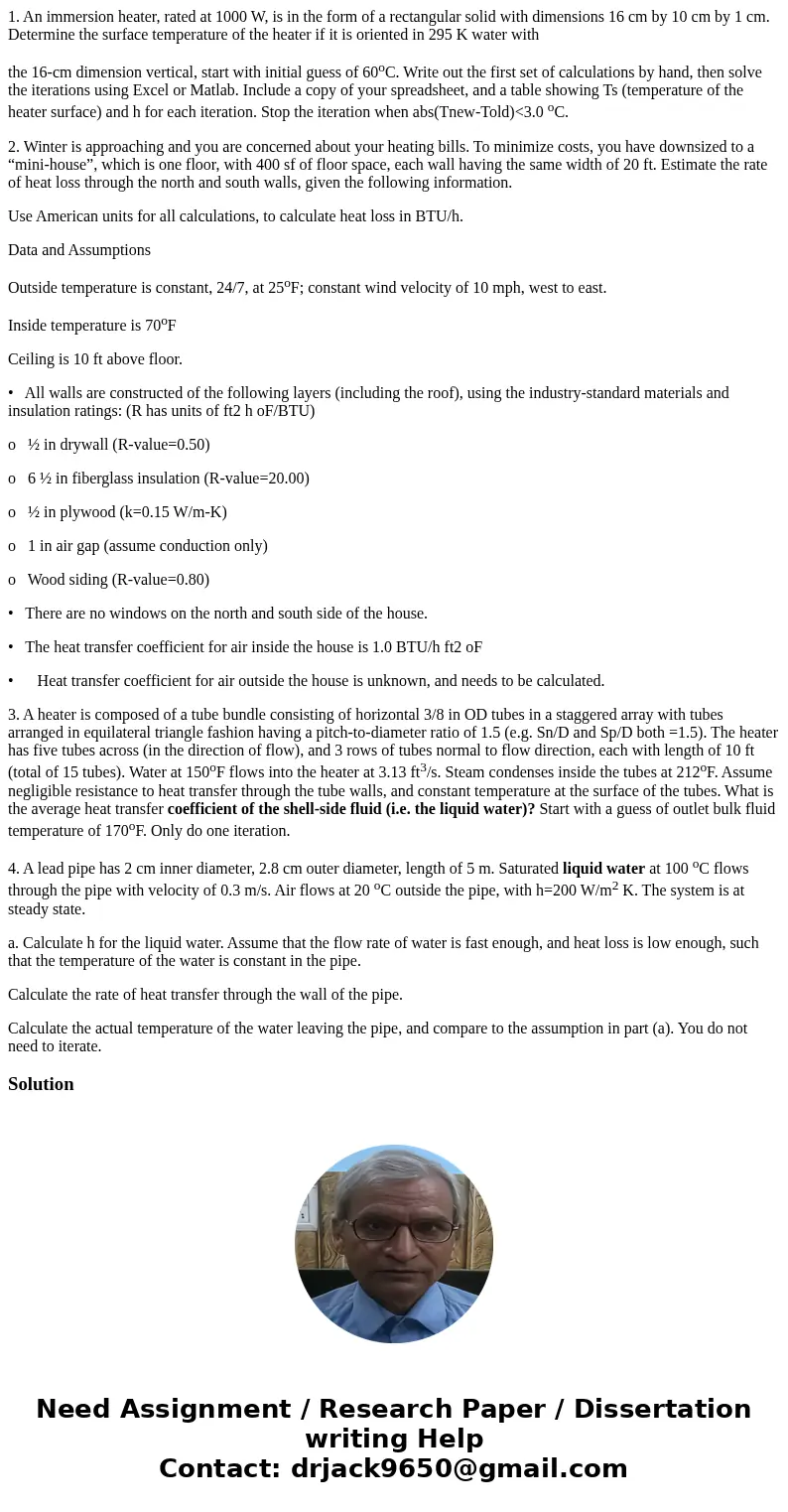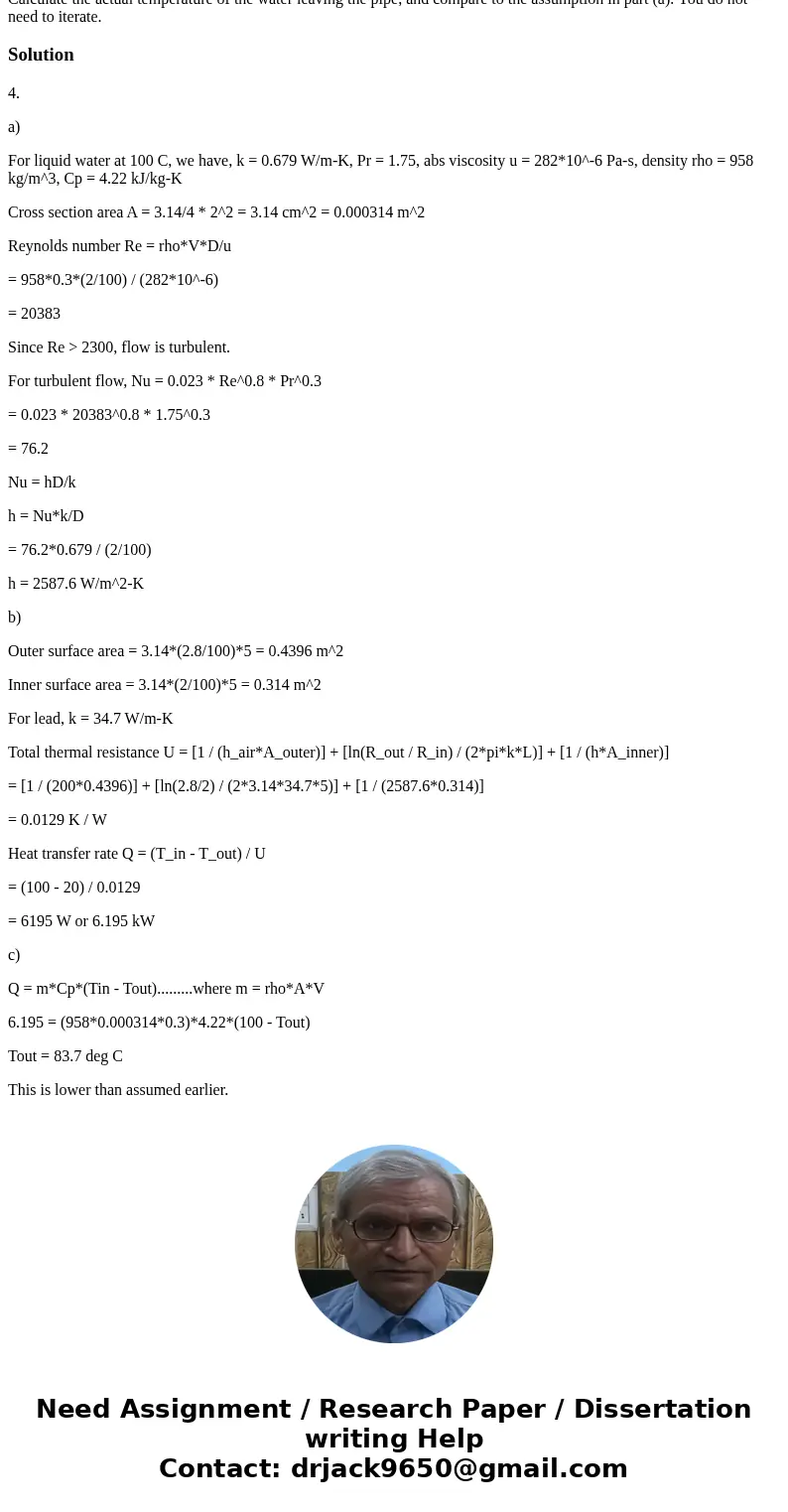1 An immersion heater rated at 1000 W is in the form of a re
1. An immersion heater, rated at 1000 W, is in the form of a rectangular solid with dimensions 16 cm by 10 cm by 1 cm. Determine the surface temperature of the heater if it is oriented in 295 K water with
the 16-cm dimension vertical, start with initial guess of 60oC. Write out the first set of calculations by hand, then solve the iterations using Excel or Matlab. Include a copy of your spreadsheet, and a table showing Ts (temperature of the heater surface) and h for each iteration. Stop the iteration when abs(Tnew-Told)<3.0 oC.
2. Winter is approaching and you are concerned about your heating bills. To minimize costs, you have downsized to a “mini-house”, which is one floor, with 400 sf of floor space, each wall having the same width of 20 ft. Estimate the rate of heat loss through the north and south walls, given the following information.
Use American units for all calculations, to calculate heat loss in BTU/h.
Data and Assumptions
Outside temperature is constant, 24/7, at 25oF; constant wind velocity of 10 mph, west to east.
Inside temperature is 70oF
Ceiling is 10 ft above floor.
• All walls are constructed of the following layers (including the roof), using the industry-standard materials and insulation ratings: (R has units of ft2 h oF/BTU)
o ½ in drywall (R-value=0.50)
o 6 ½ in fiberglass insulation (R-value=20.00)
o ½ in plywood (k=0.15 W/m-K)
o 1 in air gap (assume conduction only)
o Wood siding (R-value=0.80)
• There are no windows on the north and south side of the house.
• The heat transfer coefficient for air inside the house is 1.0 BTU/h ft2 oF
• Heat transfer coefficient for air outside the house is unknown, and needs to be calculated.
3. A heater is composed of a tube bundle consisting of horizontal 3/8 in OD tubes in a staggered array with tubes arranged in equilateral triangle fashion having a pitch-to-diameter ratio of 1.5 (e.g. Sn/D and Sp/D both =1.5). The heater has five tubes across (in the direction of flow), and 3 rows of tubes normal to flow direction, each with length of 10 ft (total of 15 tubes). Water at 150oF flows into the heater at 3.13 ft3/s. Steam condenses inside the tubes at 212oF. Assume negligible resistance to heat transfer through the tube walls, and constant temperature at the surface of the tubes. What is the average heat transfer coefficient of the shell-side fluid (i.e. the liquid water)? Start with a guess of outlet bulk fluid temperature of 170oF. Only do one iteration.
4. A lead pipe has 2 cm inner diameter, 2.8 cm outer diameter, length of 5 m. Saturated liquid water at 100 oC flows through the pipe with velocity of 0.3 m/s. Air flows at 20 oC outside the pipe, with h=200 W/m2 K. The system is at steady state.
a. Calculate h for the liquid water. Assume that the flow rate of water is fast enough, and heat loss is low enough, such that the temperature of the water is constant in the pipe.
Calculate the rate of heat transfer through the wall of the pipe.
Calculate the actual temperature of the water leaving the pipe, and compare to the assumption in part (a). You do not need to iterate.
Solution
4.
a)
For liquid water at 100 C, we have, k = 0.679 W/m-K, Pr = 1.75, abs viscosity u = 282*10^-6 Pa-s, density rho = 958 kg/m^3, Cp = 4.22 kJ/kg-K
Cross section area A = 3.14/4 * 2^2 = 3.14 cm^2 = 0.000314 m^2
Reynolds number Re = rho*V*D/u
= 958*0.3*(2/100) / (282*10^-6)
= 20383
Since Re > 2300, flow is turbulent.
For turbulent flow, Nu = 0.023 * Re^0.8 * Pr^0.3
= 0.023 * 20383^0.8 * 1.75^0.3
= 76.2
Nu = hD/k
h = Nu*k/D
= 76.2*0.679 / (2/100)
h = 2587.6 W/m^2-K
b)
Outer surface area = 3.14*(2.8/100)*5 = 0.4396 m^2
Inner surface area = 3.14*(2/100)*5 = 0.314 m^2
For lead, k = 34.7 W/m-K
Total thermal resistance U = [1 / (h_air*A_outer)] + [ln(R_out / R_in) / (2*pi*k*L)] + [1 / (h*A_inner)]
= [1 / (200*0.4396)] + [ln(2.8/2) / (2*3.14*34.7*5)] + [1 / (2587.6*0.314)]
= 0.0129 K / W
Heat transfer rate Q = (T_in - T_out) / U
= (100 - 20) / 0.0129
= 6195 W or 6.195 kW
c)
Q = m*Cp*(Tin - Tout).........where m = rho*A*V
6.195 = (958*0.000314*0.3)*4.22*(100 - Tout)
Tout = 83.7 deg C
This is lower than assumed earlier.


 Homework Sourse
Homework Sourse